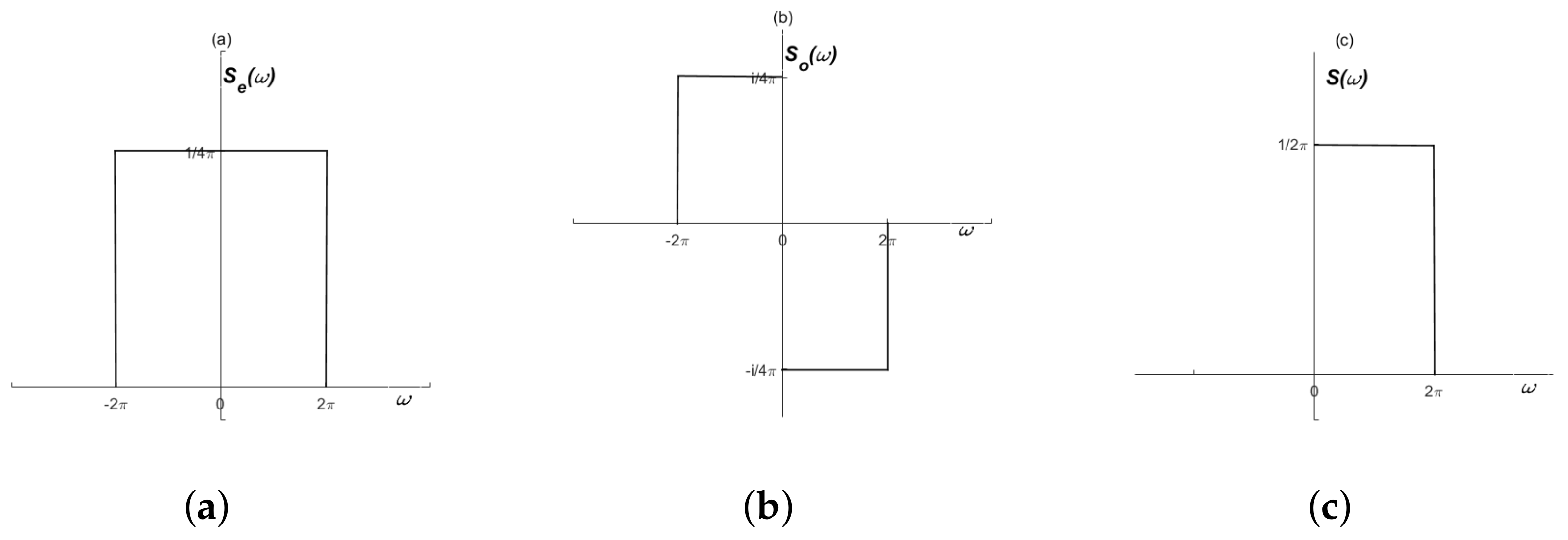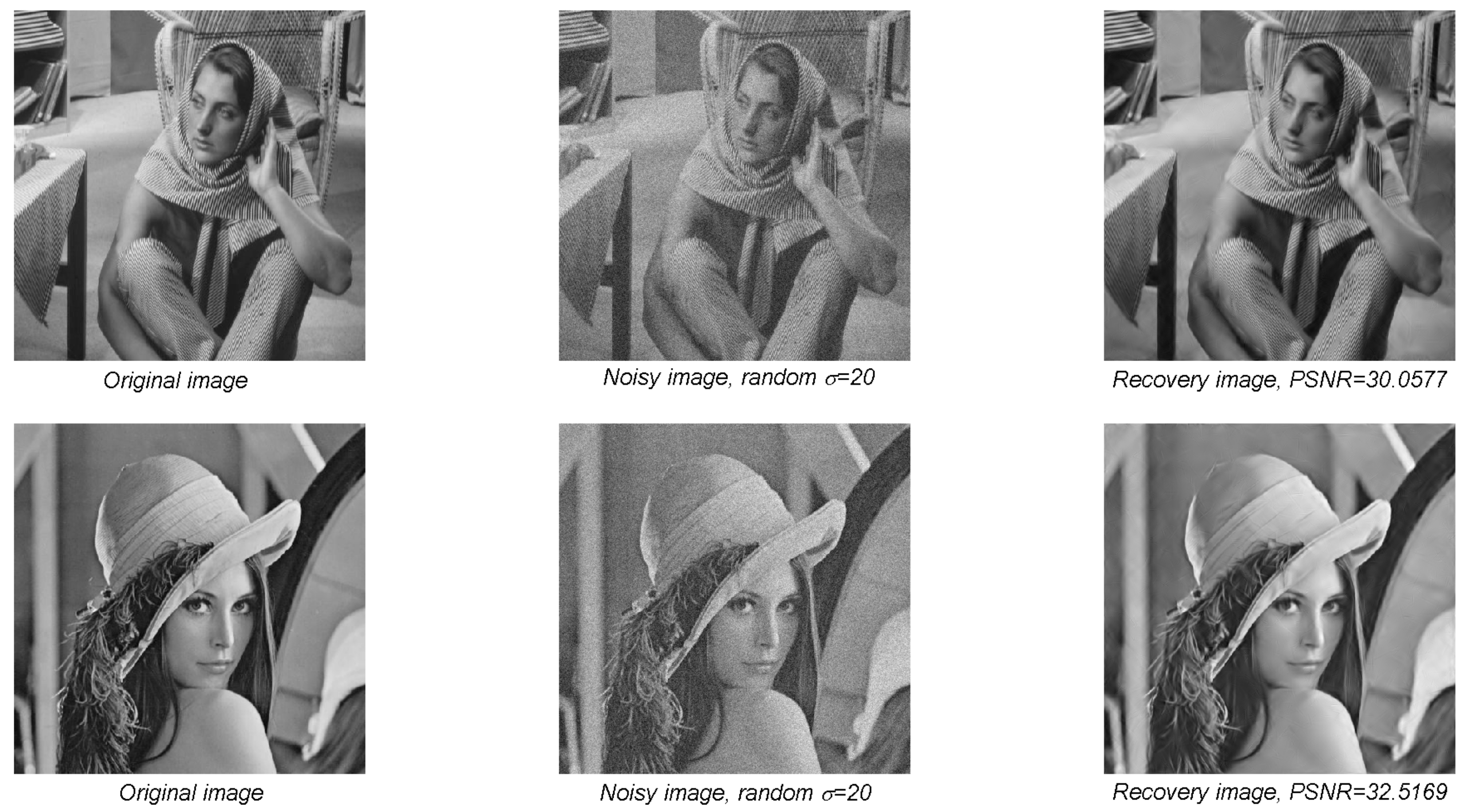A Framework for Circular Multilevel Systems in the Frequency Domain
Abstract
:1. Introduction
2. Preliminary
The Basic Definition
3. The Circular-Shape Fourier Transform (CFT)
3.1. The Pseudo-Polar Grid
3.2. The Circular-Polar Grid (CPG)
3.3. The Choice of Weights
4. The Construction of Multilevel System in Frequency Domain
4.1. 2D Basic Harmonic Function
4.2. The Polar Harmonic Multilevel System in the Frequency Domain (PHMS) on CPG
5. Quantitative Test Measures
- Isometry of :
- (a)
- Closeness to tight:
- (b)
- Quality of preconditioning.
- Tight Frame Property: The operator norm , which is defined as
- Robustness:
- (a)
- Thresholding: Let u be the regular sampling of a Gaussian function with mean 0 and variance 512 on generating an image. Two types of robustness are considered, for , and .
- :
- discards percent of coefficient, with .
- :
- keeps the absolute value of coefficients bigger than with m is the maximal absolute value of all coefficients, where .
- (b)
- Quantization: The quality measure is given as where , and .
6. Test Results
7. Conclusions
Acknowledgments
Author Contributions
Conflicts of Interest
Abbreviations
| CPG | Circular-polar grid |
| MRA | Multiresolution analysis |
| CFT | Circular-shape Fourier transform |
| CMS | Circular-shape directional multilevel system |
| PHMS | Polar harmonic multilevel system |
References
- Mallat, S.G. A Theory for Multiresolution Signal Decomposition: The Wavelet Representation. IEEE Trans. Pattern Anal. Mach. Intell. 1989, 11, 674–693. [Google Scholar] [CrossRef]
- Leng, J.; Huang, T.; Jing, Y.; Jiang, W. A Study on Conjugate Quadrature Filters. EURASIP J. Adv. Signal Process. 2011, 2011, 2317–2329. [Google Scholar] [CrossRef]
- Leng, J.; Cheng, Z.; Huang, T.; Lai, C. Construction and properties of multiwavelet packets with arbitrary scale and the related algorithms of decomposition and reconstruction. Comput. Math. Appl. 2006, 51, 1663–1676. [Google Scholar] [CrossRef]
- Leng, J.; Huang, T.; Fu, Y. Construction of bivariate nonseparable compactly supported biorthogonal wavelets. In Proceedings of the International Conference on Machine Learning and Cybernetics IEEE, Kunming, China, 12–15 July 2008. [Google Scholar]
- Averbuch, A.; Coifman, R.R.; Donoho, D.L.; Israeli, M.; Shkolnisky, Y. A Framework for Discrete Integral Transformations I-The Pseudopolar Fourier Transform. Siam J. Sci. Comput. 2007, 30, 764–784. [Google Scholar] [CrossRef]
- Bailey, D.H.; Swarztrauber, P.N. The Fractional Fourier Transform and Applications. SIAM Rev. 1991, 33, 389–404. [Google Scholar] [CrossRef]
- Rabiner, L.R. Chirp Z-transform algorithm. IEEE Trans. Audio Electroacoust. 1969, 17, 86–92. [Google Scholar] [CrossRef]
- Candes, E.J.; Donoho, D.L. New tight frames of curvelets and optimal representations of objects with smooth singularities. Commun. Pure Appl. Math. 2004, 57, 219–266. [Google Scholar] [CrossRef]
- Do, M.N.; Vetterli, M. The contourlet transform: an efficient directional multiresolution image representation. IEEE Trans. Image Process. 2005, 14, 2091–2106. [Google Scholar] [CrossRef] [PubMed]
- Kutyniok, G.; Shahram, M.; Zhuang, X. ShearLab: A Rational Design of a Digital Parabolic Scaling Algorithm. Siam J. Imaging Sci. 2011, 5, 1291–1332. [Google Scholar] [CrossRef]
- Kutyniok, G. Shearlets. In Applied and Numerical Harmonic Analysis; Springer: Birkhauser Basel, Berlin, Germany, 2012. [Google Scholar]
- Newland, D.E. Harmonic Wavelet Analysis. Proc. R. Soc. Math. Phys. Eng. Sci. 1993, 443, 203–225. [Google Scholar] [CrossRef]
- Cattani, C. Harmonic wavelets towards solution of nonlinear PDE. Comput. Math. Appl. 2005, 50, 1191–1210. [Google Scholar] [CrossRef]
- Cattani, C. Fractals Based on Harmonic Wavelets. In Proceedings of the International Conference on Computational Science and Its Applications, Seoul, South Korea, 29 June–2 July 2009; Springer: Berlin, Heidelberg, 2009; pp. 729–744. [Google Scholar]
- Cattani, C. Harmonic wavelet approximation of random, fractal and high frequency signals. Telecommun. Syst. 2010, 43, 207–217. [Google Scholar] [CrossRef]
- Haar, A. Zur Theorie der orthogonalen Funktionensysteme. Math. Ann. 1911, 71, 38–53. [Google Scholar] [CrossRef]
- Duan, X.; Leng, J.; Cattani, C.; Li, C. A Shannon-Runge-Kutta-Gill Method for Convection-Diffusion Equations. Math. Probl. Eng. 2013, 46, 532–546. [Google Scholar] [CrossRef]
- Cai, J.; Ji, H.; Liu, C.; Shen, Z. Framelet. IEEE Trans. Image Process. 2012, 21, 562–572. [Google Scholar] [PubMed]





| 0.00946092 | 1.9342627 | 0.1036731 |
| 3.6 × 10 | 1.7 × 10 | 5.9 × 10 | 2.1 × 10 | 0.9 × 10 | |
| 0.009 | 0.063 | 0.103 | 0.172 | 0.197 | |
| 0.051 | 0.065 | 0.083 | 0.126 | 0.143 |
© 2018 by the authors. Licensee MDPI, Basel, Switzerland. This article is an open access article distributed under the terms and conditions of the Creative Commons Attribution (CC BY) license (http://creativecommons.org/licenses/by/4.0/).
Share and Cite
Sun, G.; Leng, J.; Cattani, C. A Framework for Circular Multilevel Systems in the Frequency Domain. Symmetry 2018, 10, 101. https://doi.org/10.3390/sym10040101
Sun G, Leng J, Cattani C. A Framework for Circular Multilevel Systems in the Frequency Domain. Symmetry. 2018; 10(4):101. https://doi.org/10.3390/sym10040101
Chicago/Turabian StyleSun, Guomin, Jinsong Leng, and Carlo Cattani. 2018. "A Framework for Circular Multilevel Systems in the Frequency Domain" Symmetry 10, no. 4: 101. https://doi.org/10.3390/sym10040101





